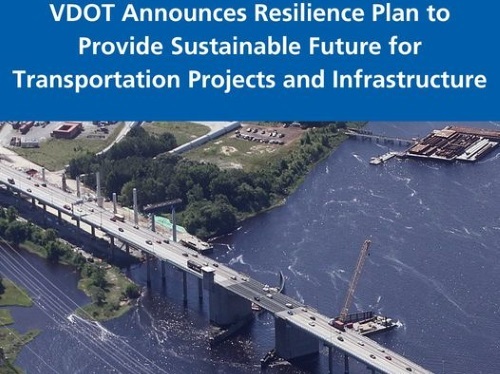The Virginia Department of Transportation recently unveiled the state’s first-ever Resilience Plan – a “formalized framework” that outlines strategies to anticipate, prepare for, and mitigate hazards that disrupt and deteriorate Virginia’s transportation network due to incidents such as recurring flooding and extreme weather events.
[Above image by Virginia DOT]
“It is our responsibility to ensure that Virginia’s transportation network continues to move people and goods safely and efficiently for generations to come,” said Virginia DOT Commissioner Stephen Brich in a statement.

“While the results of the Resilience Plan will take time to fully realize, it is an important step for the agency, as we support the Commonwealth’s goal of increasing resilience statewide and join our counterpart DOTs in working towards increasing transportation resilience across the nation,” he said.
The Resilience Plan includes six primary objectives:
- Promote Data-Driven Decisions – Virginia DOT will develop a data and research plan to ensure transportation decisions informed by the best available data and research regarding vulnerability, current and planned assets, and identified current and future conditions.
- Engage and Partner with Stakeholders – Virginia DOT will establish and implement a coordination and outreach plan that will help leverage existing efforts, maximize benefits, and ensure decision-making is coordinated with statewide policy.
- Identify At-Risk Infrastructure and Prioritize Needs – The agency will establish a risk-based methodology to measure the vulnerability across current and planned transportation infrastructure assets to support the prioritization and application of resilience efforts.
- Survey Resilience Measures – Virginia DOT will establish a suite of resilience measures that will be available for incorporation into planning, design, operations, and maintenance programs. The measures will include adaptive design criteria based upon the best available, forward-looking data; physical enhancement measures; nature-based resilience measures; operations, maintenance, and emergency management enhancement measures; and other administrative/policy measures.
- Utilize Feasibility and Cost Effectiveness Analyses – The agency will develop feasibility and economic analyses that are compatible with existing processes to ensure appropriate selection of resilience measures for application to a particular asset.
- Incorporate Resilience into Current Funding Policies – Virginia DOT will identify new funding opportunities that are available for resilience projects and initiatives and identify and implement steps to incorporate resilience into current investment processes and programs. The ultimate deployment of resilience measures relies on the effectiveness of incorporating resilience into the agency’s decision-making processes for funding programs and opportunities.
Making “resilience analysis” a cornerstone of the infrastructure decision-making process is becoming a key focal point for state departments of transportation and federal transportation agencies alike.
For example, a panel of state DOT and federal agency executives discussed infrastructure resilience planning during the American Association of State Highway and Transportation Officials 2022 Spring Meeting in New Orleans.
Moderated by David Sweeney, president and CEO of engineering and architectural firm RS&H, the panel explored how “resilience” is becoming a critical factor in extending the overall lifecycle of infrastructure assets while also hardening them against potential damage from both natural and man-made disasters.
Furthermore, a report issued by the Transportation Research Board in August 2021 urged the U.S. Department of Transportation to include resilience factors within the benefit-cost analysis for infrastructure project justifications.
TRB’s report – entitled Investing in Transportation Resilience: A Framework for Informed Choices – also recommends that resilience be measured and assessed using an “analytic framework” that incorporates detailed inventories of existing and planned assets, such as roads, runways, bridges, docks, and rail lines.
 States
States
NCDOT Staff Participate in ‘Explosive’ Technical Training
December 19, 2025 States
States

